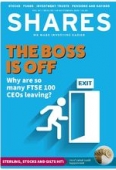Archived article
Please note that tax, investment, pension and ISA rules can change and the information and any views contained in this article may now be inaccurate.
The boss is off: why are so many FTSE 100 CEOs leaving?

There is no question this year has been an extraordinarily difficult one for many companies, who have had to cope with a sharp rise in both operating and financial costs as energy and labour prices have jumped and interest rates have gone up.
It is therefore not such a surprise that FTSE 100 chief executives are leaving in record numbers, with over a dozen either having moved already this year or due to move on in the coming months.
For investors, change at the top can be a mixed blessing depending on who takes over and how they set out their agenda.
CALLING TIME
Having led their companies through the turbulence of the last two years, from a pandemic-induced global shutdown to a dramatic recovery and an acute supply chain squeeze topped off with spiralling input costs, senior executives are understandably fatigued.
Like many of their employees, they will have been assessing their own work-life balance and wondering whether to step off the merry-go-round and let someone else take the reins.
For the bosses of firms with a largely domestic focus, the prospect of having to slog through a UK recession which could last a year or more has possibly been the final straw.
‘This is a tough time to be piloting a business and many took the job expecting to deliver shareholder value through growth, not downsizing and cutbacks,’ says James Henderson, co-manager of Henderson Opportunities Trust (HOT) and Lowland Investment Company (LWI).
There may be other factors at play too, says Henderson. The UK Corporate Governance Code introduced in 2018 means chairs and non-executive directors have a maximum term of nine years.
‘The chair who inherits you may be less patient than the one who appointed you, and non-execs are in more of a hurry to achieve something, so chief executives are under greater pressure than ever to justify their pay and given less time to do it.’
The list of those stepping down includes some of the FTSE’s most experienced executives such as Simon Arora, who has masterminded the success of store chain B&M European Value Retail (BME) for 17 years, and Halma (HLMA) boss Andrew Williams who has been at the helm of the engineering business a similar time.
On the other hand, some have been there for what seems like five minutes, like Smith & Nephew (SN.) chief executive Roland Diggelmann and Reckitt (RB.) head Laxman Narasimhan, both of whom only arrived in late 2019 and are already moving on.
Having extricated Reckitt from its disastrous 2017 acquisition of Mead Johnson, albeit at a large loss, Narasimhan has been courted by US coffee chain Starbucks (SBUX:NYSE) which is itself experiencing trouble with sales in China and is facing union protests at home so he hasn’t opted for the quiet life.
OUT WITH THE OLD
For shareholders, there are no hard-and-fast rules as to what a change of leadership means for the business and whether they should hold onto their investment or move on themselves.
‘Investors must take each case on its merits,’ says Henderson. ‘There is no easy way of telling how much difference a change at the top will make.’
Like fund managers, no two chief executives are identical, so to expect ‘more of the same’ from the newcomer may be unrealistic, although if the person taking over has been in the same industry or even the same company for some time investors may feel a sense of continuity.
Ben van Beurden’s replacement at oil producer Shell (SHEL), Wael Sawan, is unlikely to make radical changes given he is a 25-year veteran of the company and a member of the executive committee where he would have worked closely with the current chief executive.
In the case of industrial equipment rental firm Ashtead (AHT), Brendan Horgan may have seemed a relative newbie when he took over the top job in 2019 but he joined the group’s US operation Sunbelt Rentals back in 1996 and was head of that business from 2011 so he was fully grounded in the company’s way of working.
There are always exceptions, and while Mike Coupe, the Sainsbury’s (SBRY) ‘lifer’ who took over in 2014, may have been ingrained in the corporate culture, he failed to take the business forward.
As a result, he was replaced two years ago by ex-Boots and Marks & Spencer (MKS) man Simon Roberts who has invested heavily in technology to keep the grocer one step ahead of Asda and Morrisons.
Outsiders are more likely to shake things up, which can lead to problems but equally can be a good thing if change is needed.
For investors in security firm G4S, bringing in an outsider was exactly what was needed as the firm had grown too quickly and become completely unfocused under Nick Buckles.
After taking over in 2013, having been parachuted in from BG Group, Ashley Almanza took a ‘scorched earth’ approach to reshaping the business, putting no fewer than 35 poorly performing units on the chopping block while expanding the core operations in fast-growing emerging markets.
The 2021 takeover of G4S by Allied Universal for £3.8 billion, after a fierce bid battle with Canadian firm GardaWorld, was a clear vindication of the board’s decision to take a chance on Almanza.
IN WITH THE NEW
When a new chief executive does arrive, it’s important to see whether their deeds match their actions.
For instance, while they will naturally be full of praise for their new employer, do they buy any shares off their own bat and is it a credible amount or do they wait for the firm to raise capital and pick some up on the cheap?
Remuneration is also a regular bone of contention, and with pressure to keep basic salaries relatively low companies will usually bump up their directors’ pay with performance-related share awards or bonuses. Therefore, investors should scrutinise details of the new chief executive’s incentive package.
Bosses whose bonuses – which often make up most of their overall compensation – depend on share price or earnings-related targets can be prone to short-termism at best and fraud at worst, going to extreme measures to qualify for the payment.
Investors should also look closely at a chief executive’s past record on capital allocation. Have they historically been good custodians of the company’s money, reinvesting in the business for future growth, or are they acquisition junkies?
What is their attitude to leverage, how have they managed risk, and how have they dealt with the pressure from institutions to achieve short-term returns? These are all questions individual shareholders should be asking.
Trevor Green, head of UK equities at Aviva Investors, suggests as a general rule it is fair to give new arrivals 100 days to get their feet under the desk, understand the business (if they don’t already) and explain their strategy to the market.
Some new CEOs are expected to buy a substantial number of shares so their interests are aligned with other shareholders.
For example, on the day Philip Jansen was appointed as BT (BT.A) CEO in 2018, the new boss agreed to buy £2 million worth of shares within 30 days of the announcement.
BT said this was the first step towards Jansen meeting the company’s requirement that the CEO must own shares worth at least 300% of their salary.
BEYOND THE FIRST 100 DAYS
The trend for chief executives to head off into the sunset isn’t confined to the top-flight by any means.
Generally speaking, smaller companies are likely to feel a chief executive’s departure more keenly than larger ones as they operate with a tighter team, whereas larger companies have deeper management structures which means they can continue to operate like a well-oiled machine while they search for a replacement.
Earlier this month, Rupert Soames, who has turned outsourcing firm Serco (SRP) from the butt of many a joke a decade ago into a thriving company with a world-class US defence business, announced he was ‘outsourcing himself’ at the start of next year, namely stepping down as CEO.
The shares dropped nearly 7% on the news, which isn’t surprising given how ardently Soames defended the firm against a barrage of criticism during his tenure, and we can’t help but feel the company and the FTSE 250 are poorer for his decision to leave.
However, fund manager James Henderson warns against making snap judgements. He says: ‘The share price may take a tumble on the day a departure is announced but it often recovers sufficiently for you to judge the new appointee properly.
‘We would probably put them on closer watch for a while until we are confident in the direction of travel, and we like to meet and hear from new management quickly.’
SWITCHING FIRMS
Another imminent mover is Gavin Slark, who announced in July he was moving on from builders’ merchant and DIY firm Grafton Group (GFTU) after 11 years at the top, having greatly improved the company’s returns and successfully expanded its geographic footprint in the Netherlands and Nordic region.
Slark isn’t disappearing altogether, though, as he is replacing Steve Francis as chief executive of insulation firm SIG (SHI) next February.
Finally, we have to applaud Greg Fitzgerald and the team at developer Vistry (VTY) for bidding for rival Countryside Partnerships (CSP) while it was in management limbo with no chairman and the chief executive role being shared on an interim basis.
No doubt the rest of the companies in the FTSE 250 have taken note and succession plans are being hastily drawn up.
Important information:
These articles are provided by Shares magazine which is published by AJ Bell Media, a part of AJ Bell. Shares is not written by AJ Bell.
Shares is provided for your general information and use and is not a personal recommendation to invest. It is not intended to be relied upon by you in making or not making any investment decisions. The investments referred to in these articles will not be suitable for all investors. If in doubt please seek appropriate independent financial advice.
Investors acting on the information in these articles do so at their own risk and AJ Bell Media and its staff do not accept liability for losses suffered by investors as a result of their investment decisions.

 magazine
magazine










